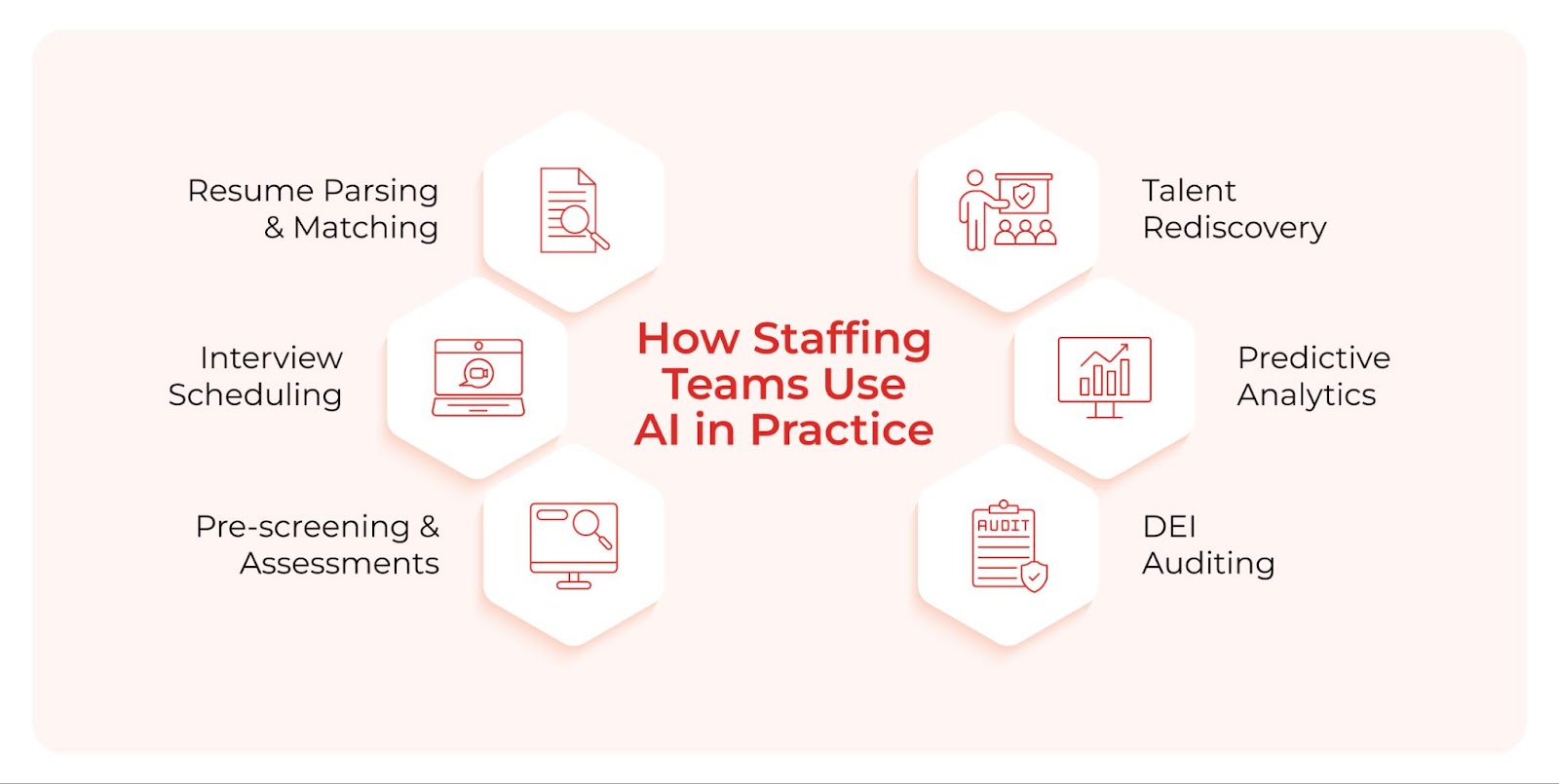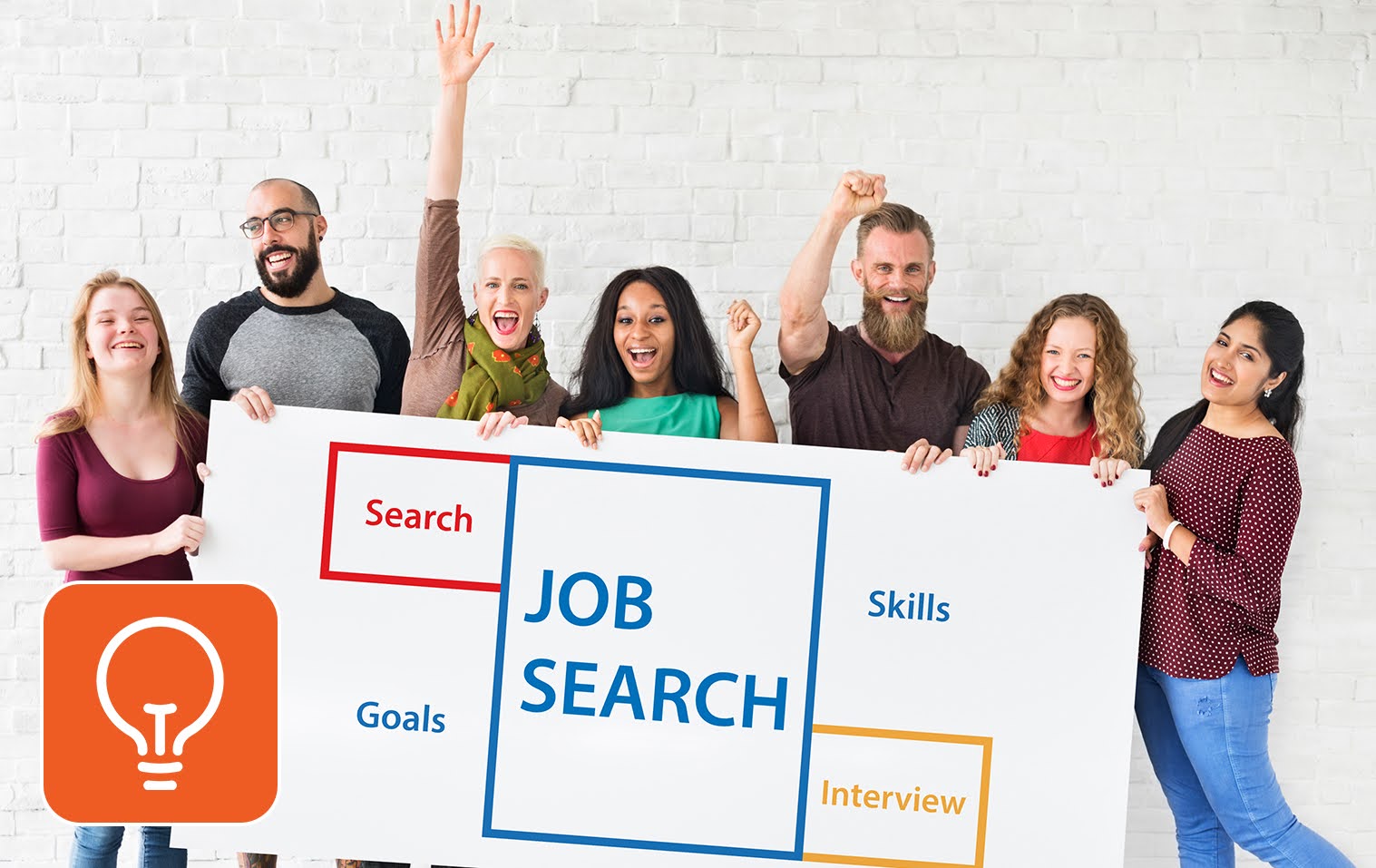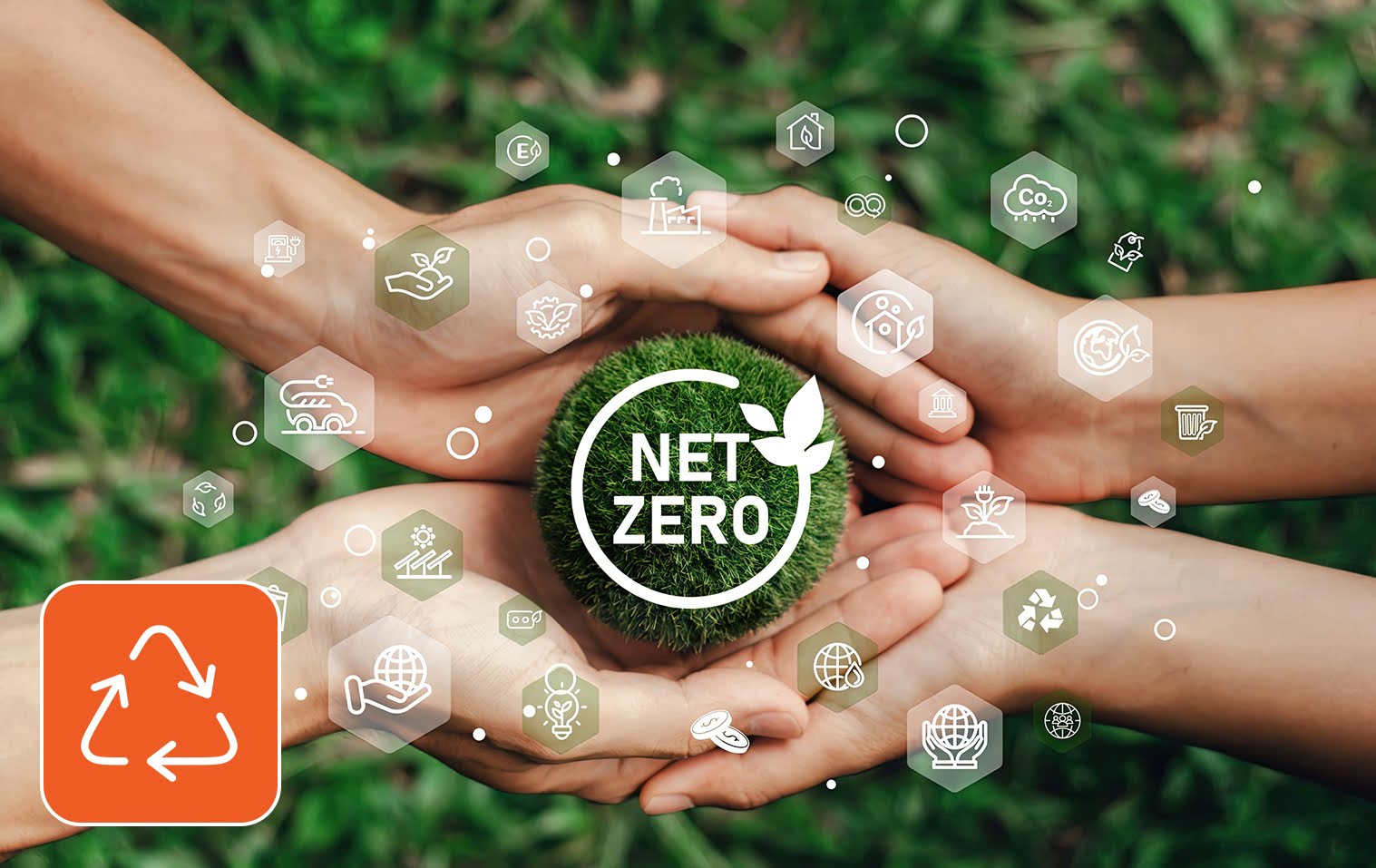You just posted a critical job opening, and within hours, 300 resumes flood in. Your best candidate? Gone before the first round even starts. Sound familiar? That’s the reality HR leaders face today. Too much noise, too little time, and talent slipping through the cracks.
What’s missing? Precision. Speed. Insight.
That’s exactly what AI staffing solutions deliver. This isn’t about replacing recruiters but removing the friction. AI helps staffing teams cut through the noise, automate repetitive tasks, and surface the right talent faster. The result? Hiring decisions that aren’t just fast —they’re right, too.
What Are AI and Automation in Staffing?
AI and automation are transforming the way hiring gets done — not by replacing recruiters, but by enhancing human efforts and aiding with smarter decision-making.
Artificial Intelligence (AI) in staffing refers to the use of algorithms and machine learning to analyze large volumes of data, including candidate resumes, job descriptions, and historical hiring patterns. Using the results, these tools can then identify stronger matches, raise red flags, and even predict outcomes like offer acceptance or attrition risk. Instead of relying purely on manual judgment, recruiters gain access to data-driven insights that improve both speed and accuracy in hiring decisions.
Automation, on the other hand, handles the repetitive and time-consuming tasks that don’t require human intervention. Think about parsing resumes, scheduling interviews, and sending reminders and follow-ups. These automated workflows streamline communication and logistics, helping teams move faster and stay organized, especially in high-volume or deadline-driven hiring environments.
Together, AI and automation free up recruiters to focus on what they do best: engaging candidates, building relationships, and making strategic hiring decisions. They bring precision and consistency to a process that may otherwise be slowed by human bias and burnout.
Why AI Staffing Solutions Are Worth Your Attention
It’s one thing to know what AI does; it’s another to see what it makes possible within staffing solutions.
Imagine this: you’ve just been handed a requisition to hire 100 people for a time-sensitive project. Traditionally, that would mean weeks of resume screening, scheduling chaos, and recruiter overload. But with AI in your toolkit, the entire workflow changes. Matching algorithms shortlist top candidates instantly. Automated workflows handle outreach, interview coordination, and follow-ups. Instead of scrambling, your team is filling roles within days, not weeks, with better outcomes and less friction.
That’s the real power of AI staffing solutions. They unlock scale, speed, and accuracy at a level that manual processes simply can’t match. Here’s a breakdown of what that looks like for recruiters and HR leaders:
1. Reducing time-to-hire
AI tools can instantly scan thousands of resumes, shortlist candidates based on fit, and even rank them. Combined with automated screening workflows and interview scheduling, this significantly cuts the time between job posting and offer rollout.
2. Improving candidate matching
Traditional keyword matching is blunt. AI understands context, picking up on skills, adjacent roles, and career progression patterns. This leads to stronger shortlists and better hiring outcomes.
3. Eliminating repetitive tasks
From resume screening to sending follow-up emails, staffing automation takes over low-value, high-effort tasks, allowing recruiters to focus on human conversations and strategic decisions.
4. Reducing Bias in Hiring
When trained responsibly, AI can ignore demographic cues and prioritize qualifications and experience. It introduces consistency in shortlisting, reducing the impact of unconscious bias, which is one of the most persistent recruitment challenges.
5. Enhancing Candidate Experience
AI-driven chatbots can respond instantly to candidate queries, provide status updates, and guide them through next steps, improving transparency and engagement across the process.
Read more about strategic staffing in our detailed blog about staffing solutions here.
How staffing teams are using AI in practice
AI is no longer limited to early-stage screening. It’s embedded across the strategic staffing solutions lifecycle. Here’s what it currently facilitates:

- Resume parsing & matching: AI engines like SPECTRAFORCE’s Arya parse candidate data with semantic accuracy, matching them to jobs based on context, intent, and fit, and not just keywords.
- Interview scheduling: Tools can now automate scheduling based on interviewer availability and candidate preference, reducing back-and-forth and drop-offs.
- Pre-screening & assessments: AI hiring tools also use gamified cognitive or behavioral assessments to predict role fit.
- Talent rediscovery: Instead of sourcing from scratch, AI can search your ATS for previous applicants who fit new roles.
- Predictive analytics: Some systems analyze past hiring patterns to forecast candidate success, team compatibility, or likelihood of acceptance, guiding recruiter decisions before the first call.
- DEI auditing: Certain tools now provide bias audit trails, showing how decisions were made and flagging disparities in selection outcomes.
Potential Challenges & Ethical Considerations to Watch Out For
Let’s say a client urgently needs to fill dozens of roles, and time is tight. You fire up your AI hiring platform, confident it will handle screening in minutes. But a few days in, your recruiters raise flags: strong candidates are slipping through the cracks, some others are progressing without a clear rationale, and a few applicants are left wondering if anyone’s even reading their resumes.
Sound familiar?
While AI staffing solutions like Arya AI by SPECTRAFORCE are built to enhance efficiency and decision-making, ethical implementation has always remained key. The goal for us isn’t just speed — it’s trustworthy, equitable hiring at scale. That means looking beyond what AI can do and focusing on how it does it.
Here are some of the key challenges every staffing leader should be aware of:
1. Data bias
AI learns from historical data. If that data reflects biased hiring practices, the algorithm may amplify, not correct those patterns. The risk is especially high in legacy ATS datasets with poor demographic diversity.
2. Transparency and explainability
Recruiters must be able to explain why a candidate was rejected or selected. But many AI models are black boxes, offering no audit trail for decisions. This poses legal and reputational risks.
3. Over-automation
Relying too heavily on automation in recruitment can backfire. Imagine this: a promising candidate drops out midway because your automated system sent them the wrong interview slot, and no one caught it in time. That’s the downside of over-automation. Without the right checks, small errors can cost you big opportunities. Candidates may feel ghosted, processes may miss nuance, and top talent may walk away due to a lack of human touch.
4. Compliance and data privacy
AI hiring tools process massive volumes of personal data. Without proper compliance (GDPR, CCPA), staffing firms could face legal exposure.
With Arya AI, we’ve built those principles into the foundation because ethical hiring isn’t optional; it’s the future. Responsible design, transparent use, focus on cybersecurity, and regular audits must be part of any staffing model using automation.
Future Outlook: Where AI Staffing Solutions Are Headed
AI in staffing is evolving (and accelerating). Here’s a quick (not exhaustive) look at what the future will entail:
- Multimodal AI will analyze voice, video, and text during interviews for richer assessments.
- Hyper-personalization will tailor job recommendations to candidate behavior and preferences in real time.
- Internal mobility engines will become smarter, helping companies match existing employees to open roles.
- Autonomous sourcing tools may soon write and A/B test job ads on their own, optimizing candidate attraction.
- AI-driven upskilling platforms will help staffing agencies not only fill roles, but actively prepare candidates for future opportunities.
According to McKinsey’s 2024 State of AI report, 78% of organizations have adopted AI in at least one business function. Talent Acquisition is among the leading areas of implementation, and we will see uptake going up in the coming years.
Conclusion: Human-Centred Hiring in an AI-Powered World
The goal of AI staffing solutions isn’t to remove humans from the recruitment workflow—it’s to remove friction, guesswork, and inefficiency.
When done right, AI empowers recruiters to identify better candidates faster. It expands access to talent and introduces structure and insight into decisions that were once driven by pure instinct.
But the future of recruitment still depends on trust, empathy, and strategic thinking, which are uniquely human traits. The most forward-thinking staffing agencies aren’t choosing between AI and people — they’re building systems where each uplifts and amplifies the other.
Want to see how a smartly engineered AI staffing solution can transform your hiring process? Talk to SPECTRAFORCE experts today.
FAQs
1. How do AI staffing solutions address skill shortages in specific industries?
AI tools like SPECTRAFORCE’s Arya analyze large volumes of candidate data across roles, industries, and geographies. They go beyond resumes to understand context like adjacent skills, project experience, and progression paths, helping identify talent that may not surface through traditional sourcing.
In skill-short industries like healthcare, IT, or manufacturing, this allows recruiters to broaden their candidate pool without compromising on fit.
2. Can AI help reduce employee turnover rates?
Yes. AI-backed staffing solutions often integrate behavioral assessments, cultural fit analyses, and predictive modeling to flag candidates who may be misaligned with the role or team.
This proactive approach results in stronger matches, better onboarding experiences, and higher retention. Over time, reduced churn translates to lower hiring costs and stronger team continuity.
3. What strategies do AI staffing platforms use to attract top talent?
AI tools optimize job descriptions using real-time market data, personalize outreach based on candidate behavior, and automate follow-ups to reduce drop-off.
Some platforms also use multichannel sourcing (email, social, programmatic ads) and dynamic job matching to meet candidates where they are, fast and with relevance.
4. How can AI assist with hard-to-fill roles?
For niche or confidential roles, AI enables what’s called “intent-aware sourcing.” These systems detect passive candidates who show subtle job-change signals (profile updates, skill endorsements, browsing behavior) and prioritize them.
AI also scans internal talent pipelines (ATS databases) for previously engaged candidates who meet current requirements, a process known as talent rediscovery.
5. Are AI staffing solutions cost-effective for small or mid-sized businesses?
Yes, especially when compared to the cumulative cost of bad hires, long vacancies, and recruiter burnout. AI tools help smaller businesses compete with larger firms by speeding up hiring, enhancing candidate experience, and cutting down on administrative overhead.
Many platforms also offer scalable pricing models based on hiring volume, not enterprise size.



